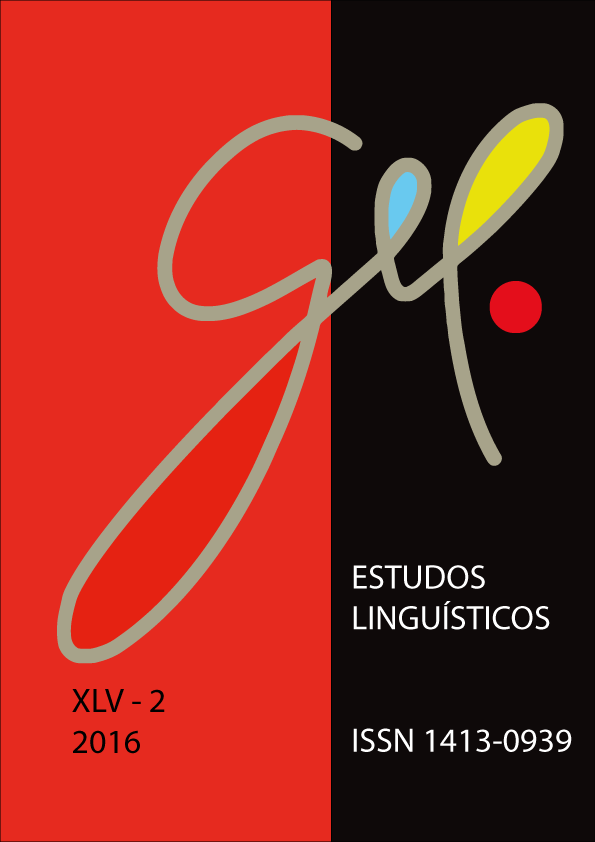Linguistic Landscape as a Tool for Linguistic Policies in a Swabian/German Immigration Colony
DOI:
https://doi.org/10.21165/el.v45i2.652Keywords:
linguistic landscape, language policies, identity politics.Abstract
This study aims to demonstrate the linguistic landscape of a Swabian/German immigration colony in Paraná state and to understand how the local languages are available and represented in public spaces within the colony. In addition, by understanding linguistic landscape as a language policy instrument, it is discussed how this tool works on the construction of the ethnic and linguistic identity of the group. This is an ethnographic qualitative research, according to Blommaert (2010). The collected material is analyzed under the theoretical and methodological perspective from the field of linguistic landscapes (BLOMMAERT, 2006, 2012, 2013; SHOHAMY, 2012), and studies on multilingual contexts (MAHER, 1996, 2010, 2013; ASSIS-PETERSON, 2008).
Downloads
References
ASSIS-PETERSON, A. A. Como ser feliz no meio de anglicismos: processos transglóssicos e transculturais. Trab. Ling. Aplic., Campinas, 47(2), p. 323-340, jul./dez. 2008.
BLOMMAERT, J. A sociolinguistics of globalization. Cambridge University Press: 2010, 231 p.
BLOMMAERT, J. Chronicles of complexity: Ethnography, superdiversity, and linguistic landscapes. Bristol: Multilingual matters, 2012. 150 p.
BLOMMAERT, J. Further notes on sociolinguistic scales. London: Working Papers Urban Language & Literacies, 2006. 8 p.
BLOMMAERT, J.; MALY, I. Ethnographic linguistic landscape analysis and social change: A case study. Tilburg papers in culture studies. Paper 100, June 2014.
CAVALCANTI, M. C. Estudos sobre educação bilíngue e escolarização em contextos de minorias linguísticas no Brasil. DELTA, v. 15, p. 385-417, 1999.
CAVALCANTI, M. C. Línguas ilegítimas em uma visão ampliada de educação linguística. In: ZILLES, A. M. S.; FARACO, C. A. (org.). Pedagogia da variação linguística: língua, diversidade e ensino. São Paulo: Parábola, 2015. p. 287-302.
CENOZ, J.; GORTER, D. Linguistic Landscape as an additional source of input in second language acquisition, IRAL, International Review of Applied Linguistics in Language Teaching, 46, p. 257-276, 2008a.
CENOZ, J.; GORTER, D. Knowledge about language and linguistic landscape. In: CENOZ, J.; HORNBERGER, N. H. (eds). Encyclopedia of Language and Education, 2nd Edition, v. 6: Knowledge about Language, p. 1-13, 2008b.
CENOZ, J.; GORTER, D. Linguistic Landscape and Minority Languages. International Journal of Multilingualism. v. 3, n. 1, 2006.
DALLA VECCHIA, A. Políticas linguísticas na Colônia “alemã” de Entre Rios: o papel do Colégio Imperatriz Dona Leopoldina. 2013. 187 f. Dissertação (Mestrado em Linguagem, Identidade e Subjetividade.) – Universidade Estadual de Ponta Grossa, Pronta Grossa, 2013.
ELFES, A. Suábios no Paraná. Curitiba: Banco Lar Brasileiro S.A., 1971. 115 p.
HAMEL, R. E. Directos Linguísticos como Directos Humanos: debates e perspectivas. In: OLIVEIRA, G. M. (org.). Declaração Universal dos Direitos Linguísticos – Novas perspectivas em Políticas Linguísticas. Campinas: Mercado de Letras; Florianópolis: IPOL, 2003. p. 47-80.
JACQUEMET, M. Transidiomatic practices: Language and power in the age of globalization. Language & Communication, v. 25, Issue 3, p. 257-277, July 2005.
MAHER, T. M. Ser Professor Sendo Índio: Questões de Lingua(gem) e Identidade. 1996. 261 f. Tese (Doutorado em Linguística) – Instituto de Estudos da Linguagem, Universidade Estadual de Campinas.
MAHER, T. M. Políticas linguísticas e políticas de identidade: currículo e representações de professores indígenas na Amazônia ocidental brasileira. Currículo sem Fronteiras, v. 10, n. 1, p. 33-48, jan./jun. 2010.
MAHER, T. M. Ecos de resistência: políticas linguísticas e línguas minoritárias no Brasil. In: NICOLAIDES, C. et al. (orgs.). Política e políticas linguísticas. Campinas: Pontes Editores, 2013. p.117-134.
OLIVEIRA, G. M. As línguas Brasileiras e os Direitos Linguísticos. In: OLIVEIRA, G. M. (org.). Declaração dos Direitos Linguísticos – Novas Perspectivas em Políticas Linguísticas. Campinas: Mercado de Letras, ALB; Florianópolis: IPOL, 2003. p. 7-12.
OLIVEIRA, K. P. O comportamento linguístico da comunidade de Entre Rios: identidade, prestígio e estigma linguístico. Ponta Grossa: UEPG, 2013. 60 p.
PERES, E. P. Aspectos da imigração italiana no Espírito Santo: a língua e cultura do Vêneto em Araguaia. Dimensões – Revista de História, v. 26, p. 44-59, 2011a.
PERES, E. P. Análise da vitalidade do vêneto em uma comunidade de imigrantes italianos no Espírito Santo. Revista (Con)textos linguísticos, Vitória, v. 5, p. 83-100, 2011b.
SHOHAMY, E. Linguística Landscape and Multilingualism. In: MARTIN-JONES, M.; BLACKLEDGE, A.; CREESE, A. (org.). The Routledge of Multilingualism. Londres/Nova Yorque: Routledge, 2012. p. 538-551.
STEIN, M. O oitavo dia: produção de sentidos identitários na Colônia Entre Rios-Pr. Guarapuava: UNICENTRO, 2011. 288 p.
VERTOVEC, S. Super-diversity and its implications. Ethnic and Racial Studies, v. 30, n. 6, p. 1024-1054, 2007.



